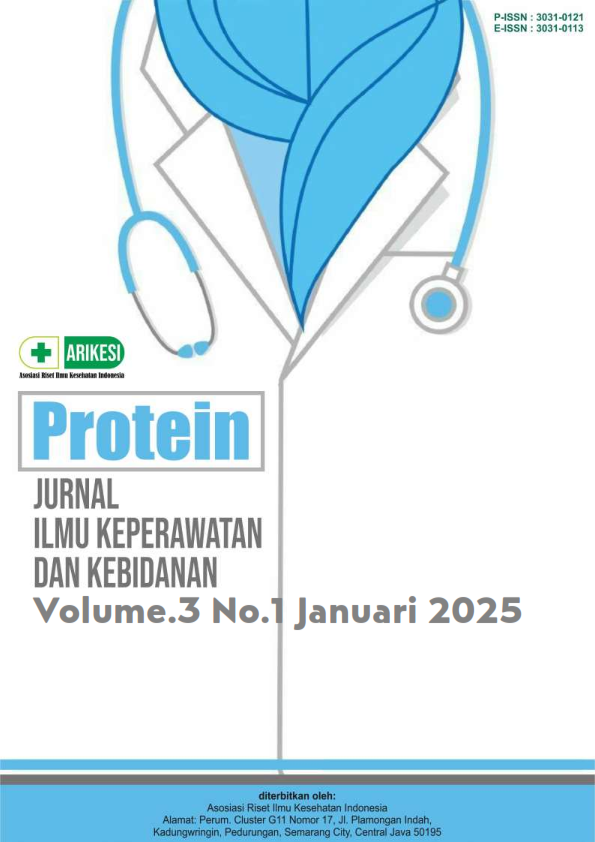Hubungan Faktor Risiko Obesitas dengan Kejadian Hipertensi di Wilayah Pelabuhan Harbour Bay Tahun 2024
DOI:
https://doi.org/10.61132/protein.v3i1.916Keywords:
Hypertension, Obesity, Port CommunityAbstract
Hypertension is a health problem that is often found in society with a prevalence in Indonesia of 30.8%, is one of the non-communicable diseases (NCDs) that are still a health problem in Indonesia because of their contribution to cardiovascular disease as a contributor to morbidity and mortality in society. This study aims to analyze the relationship between age, gender and obesity status with the incidence of hypertension, through a cross-sectional approach. The study was conducted on 219 respondents using a total sampling technique. The data obtained were analyzed univariately and bivariately. The results of the univariate analysis showed that the percentage of hypertension was 18.72% and the percentage of obesity was 40.2%. The results of the bivariate analysis using the Chi square test produced a significance level of p-value of 0.000 (significant) between age and obesity with a PR value of 3.47 (CI 1.22-9.87) for the age group above 54 years, and a PR value of 2.66 (CI 1.21-5.81) for the age group 46-54 years (with the age group 18-45 years as a reference). The results of the bivariate analysis using the Chi square test between gender and obesity produced a p-value of 0.0040 with a PR of 0.45. The results of the chi square test between obesity and hypertension were proven to be statistically significant with a PR of 1.90, meaning that respondents with obesity had a 1.9 times greater risk of suffering from hypertension than people without hypertension.
Downloads
References
Afandi, A., & Indiasworo, A. R. (2022). Perbedaan jenis kelamin pada prevalensi dan faktor risiko hipertensi pada remaja: Studi cross-sectional. Pro Health: Jurnal Ilmiah Kesehatan, 4(2), 249–252. https://doi.org/10.35473/proheallth.v4i2.1815
Amanda, D., & Martini, S. (2018). The relationship between demographical characteristic and central obesity with hypertension. Jurnal Berkala Epidemiologi, 6(1), 43–50. https://doi.org/10.20473/jbe.V6I12018.43-50
Anggreni, D. (2022). Buku ajar metodologi penelitian kesehatan. Penerbit STIKes Majapahit Mojokerto.
Direktorat Pencegahan dan Pengendalian Penyakit Tidak Menular. (2015). Buku pedoman umum pengendalian obesitas. Kementerian Kesehatan RI.
Direktorat Pencegahan dan Pengendalian Penyakit Tidak Menular. (2019). Buku pedoman manajemen penyakit tidak menular. Kementerian Kesehatan RI.
Falah, M. (2019). Hubungan jenis kelamin dengan angka kejadian hipertensi pada masyarakat di Kelurahan Tamansari Kota Tasikmalaya. Jurnal Keperawatan & Kebidanan STIKes Mitra Kencana Tasikmalaya, 3(1), 85–94.
Guyton, A. C., & Hall, J. E. (2016). Textbook of medical physiology (14th ed.). Philadelphia: Elsevier.
Herawati, C., & Yuslichah, A. (2020). Analisis faktor risiko kejadian hipertensi pada pekerja pelabuhan. Jurnal Kesehatan, 11(2), 162–170.
Kementerian Kesehatan Republik Indonesia. (2021). Hipertensi penyebab utama penyakit jantung, gagal ginjal dan stroke. Kementerian Kesehatan RI. Retrieved on 27 November 2024, from https://kemkes.go.id/id/rilis-kesehatan/hipertensi-penyebab-utama-penyakit-jantung-gagal-ginjal-dan-stroke
Kementerian Kesehatan Republik Indonesia. (2023). Survei Kesehatan Indonesia (SKI) dalam angka, data akurat kebijakan tepat. Kementerian Kesehatan RI.
Khasanah, N. A. H. (2022). Hubungan usia, jenis kelamin, dan status obesitas dengan kejadian hipertensi di wilayah Puskesmas Sumbang II Kabupaten Banyumas. Jurnal Bina Cipta Husada, 18(1), 43.
Libby, P., Bonow, R. O., Mann, D. L., Tomaselli, G. F., Bhatt, D. L., Solomon, S. D., & Braunwald, E. (Eds.). (2021). Braunwald's heart disease: A textbook of cardiovascular medicine (12th ed.). Elsevier.
Majmudar, N. G., Robson, S. C., & Ford, G. A. (2000). Effects of the menopause, gender, and estrogen replacement therapy on vascular nitric oxide activity. The Journal of Clinical Endocrinology & Metabolism, 85(4), 1577–1583. https://doi.org/10.1210/jcem.85.4.6530
Nurhayati, U. A., Ariyanto, A., & Syafriakhwan, F. (2023). Hubungan usia dan jenis kelamin terhadap kejadian hipertensi. Prosiding Seminar Nasional Penelitian dan Pengabdian kepada Masyarakat LPPM Universitas ‘Aisyiyah Yogyakarta, 1(22 Juli), 363.
Nwagbara, V. O., & McClellan, M. (2019). Age-related changes in kidney function and their implications for hypertension. American Journal of Kidney Diseases, 73(5), 624–632. https://doi.org/10.1053/j.ajkd.2018.09.017
Primayanti, O. D., Rifai, A., & Gunawan, A. (2022). Perbedaan prevalensi dan karakteristik kejadian hipertensi di daerah rural dan urban di Kabupaten Malang [Sarjana thesis]. Universitas Brawijaya. Retrieved from http://repository.ub.ac.id/id/eprint/199001
Purwo, & Denny. (2018). Faktor obesitas dan kolesterol terhadap hipertensi di Indonesia (Indonesian Family Life Survey V). Retrieved from https://jurnal.fkm.untad.ac.id/index.php/ghidza/article/view/7
Rohkuswaraa, T. D., & Syarif, S. (2016). Hubungan obesitas dengan kejadian hipertensi derajat 1 di Pos Pembinaan Terpadu Penyakit Tidak Menular (Posbindu PTM) Kantor Kesehatan Pelabuhan Bandung Tahun 2016. Jurnal Epidemiologi Kesehatan Indonesia, 1(2), Juli 2017.
Sarwono, J. (2012). Metode penelitian kuantitatif dan kualitatif. Yogyakarta: Graha Ilmu.
Sianipar, M. G. R. (2024). Hubungan sosiodemografi, obesitas, dan gaya hidup dengan kejadian hipertensi di Puskesmas Pulo Brayan Kota Medan [Skripsi Sarjana]. Universitas Sumatera Utara. Retrieved from https://repositori.usu.ac.id
World Health Organization. (2023). Noncommunicable diseases. Retrieved on 27 November 2024, from https://www.who.int/news-room/fact-sheets/detail/noncommunicable-diseases
Downloads
Published
How to Cite
Issue
Section
License
Copyright (c) 2024 Protein : Jurnal Ilmu Keperawatan dan Kebidanan.

This work is licensed under a Creative Commons Attribution-ShareAlike 4.0 International License.





